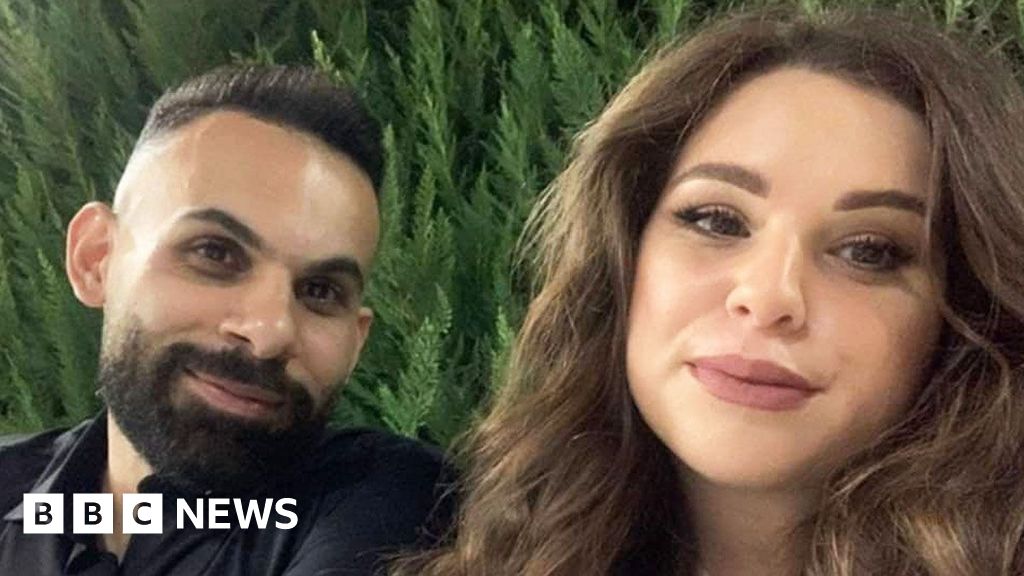Most civilians died in IDF attack on Lebanon village, BBC.
Senior international investigative correspondent, BBC World Service
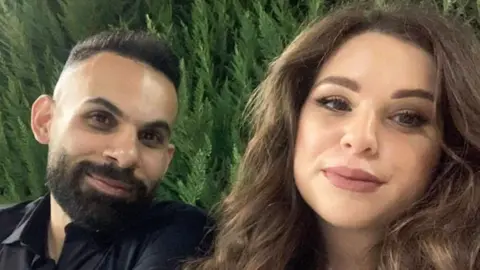 BBC
BBCJulia Ramadan was terrified – the war between Israel and Hezbollah was escalating and she had a nightmare that her family home was being bombed. When she sent her brother a voice note from her Beirut apartment, he encouraged her to join him in Ain El Del, a sleepy village in southern Lebanon.
“It’s safe here,” he reassured her. “Come stay with us until things calm down.”
Earlier that month, Israel intensified air campaigns against Hezbollah in Lebanon, in response to escalating rocket attacks by the Iran-backed militant group that killed civilians, peppering tens of thousands of homes in northern Israel.
Ashraf was confident their family’s apartment block would be a haven, so Julia joined him. But the next day, on September 29, it was subject to the bloodiest Israeli attack of this conflict. Hit by Israeli missiles, the entire six-story building collapsed, killing 73 people.
The Israel Defense Forces (IDF) say the building was targeted because it was a Hezbollah terrorist center. He added that the “overwhelming majority” of those killed in the strike were “confirmed terrorist agents.”
But the BBC’s Eye investigation verified the identities of 68 of the 73 people killed in the attack and uncovered evidence suggesting that only six were linked to Hezbollah’s military wing. None of those we have identified seem to hold a significant rank. The BBC World Service also found that the other 62 were civilians – 23 children.
Among the dead were babies just a few months old, like Nouh Kobeissi in Apartment-2B. In Apartment 1C, school teacher Abeer Halak was killed alongside her husband and three sons. Three floors above, Amal Hakawati died with three generations of her family – her husband, children and two grandchildren.
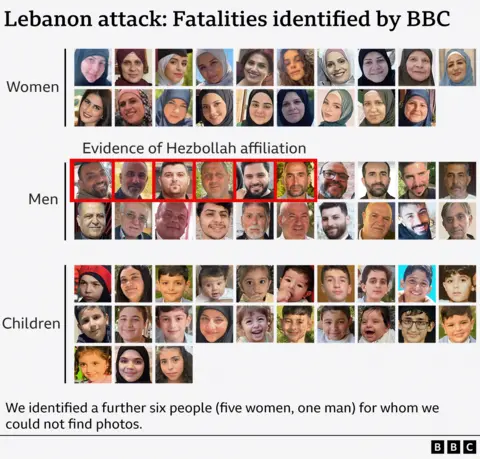
Ashraf and Julia were always close, sharing everything with each other. “It was like a black box, holding my pants,” he says.
On the afternoon of September 29, the siblings had just returned home from distributing food to families who had fled the fighting. Hundreds of thousands of people in Lebanon have been displaced due to the war.
Ashraf was in the bathroom, and Julia was sitting in the living room with their father, helping him upload a video to social media. Their mother, Yan’an, was in the kitchen, disinfecting.
Then, without warning, they heard a deafening noise. It shook the entire building, pulling a huge cloud of dust and smoke into their apartment.
“I screamed, ‘Julia! Julia!’” Ashraf says.
“I’m here,” she replied.
“I looked at my father, who was struggling to get up from the couch due to an existing leg injury, and saw my mother heading toward the front door.”
Julia’s nightmare was playing out in real life.
“Julia was hyperventilating, crying hard on the couch. I was trying to calm her down and told her we needed to get out. Then, there was another attack.”
Video footage of The Strike, shared online and verified by the BBC, reveals four Israeli missiles flying through the air towards the building. Seconds later, the block collapses.
Ashraf, along with many others, was trapped under the rubble. He started calling him, but the only voice he could hear was his father’s health, who told him he could still hear Julia and that she was alive. None of them could hear Ashraf’s mother.
Ashraf sent a voice note to friends in the neighborhood to alert them. The next few hours were painful. He could hear rescuers digging through the wreckage – and residents crying as they discovered their dead loved ones. “I kept thinking, ‘Please, God, not Julia. I can’t live this life without Julia.'”
Ashraf was finally pulled from the rubble hours later, with only minor injuries.
He found out that his mother had been saved but had died in the hospital. Julia was strangled under the rubble. His father later told him that Julia’s last words were prayers for her brother.
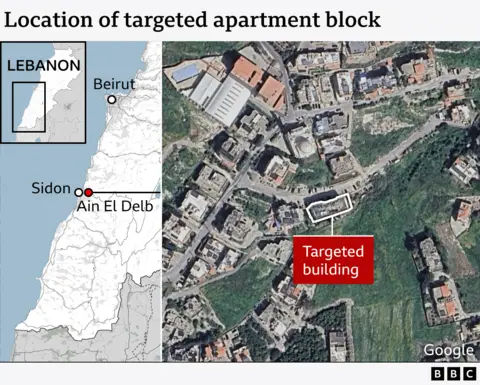
In November, a ceasefire deal was agreed between Israel and Hezbollah aimed at ending the conflict. The deal gives a 60-day deadline for Israeli forces to withdraw from southern Lebanon and Hezbollah to withdraw its forces and weapons north of the Litani River. As that January 26 deadline approaches, we sought to learn more about Israel’s deadliest attack on Lebanon in years.
In the apartment below Julia and Ashraf, Hawra and Ali Fares were hosting family members displaced by the war. Among them was Hawra’s sister Patole, who, like Julia, had arrived the day before – with her husband and two young children. They escaped intense bombardment near the Lebanon-Israel border, in areas where Hezbollah has a strong presence.
“We hesitated about where to go,” Patole says. “Then I told my husband, let’s go to Ain El Del. My sister said their building was safe and they couldn’t hear any bombing nearby.”
Batul’s husband, Mohamed Fares, was killed in the Ain El Del attack. A pillar fell on Patul and her children. She says no one responded to her calls for help. She was finally able to raise it on her own, but her four-year-old daughter, Haura, had a fatal crush on her. Miraculously, her baby Malak survived.
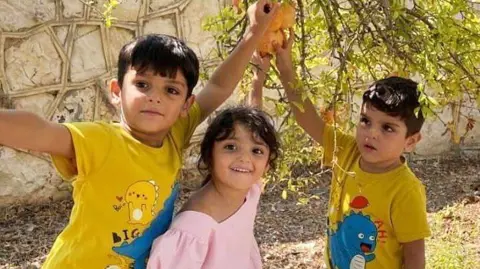 Price family
Price familyThree floors below Patole lived Denis and Mohiluddin Al-Riba. That Sunday, Denise invited her brother Hisham to lunch.
Hisham says the impact of the strike was brutal.
“The second missile slammed me to the ground…the entire wall fell on top of me.”
He spent seven hours under the rubble.
“I heard a distant voice. People talking. Yelling and…” Cover it. Take it out. Lift the stone. He’s still alive. I mean…oh my god.
When Hisham is finally rescued, he finds his niece’s fiancé waiting to hear if she is alive. He lied to him and told him she was fine. They found her body three days later.
Hisham lost four members of his family – his sister, their brother-in-law and their two children. He told us that he had lost his faith and no longer believed in God.
To learn more about who died, we analyzed Lebanese Ministry of Health data, videos and social media, as well as speaking to survivors of the attack.
We particularly wanted to interrogate the IDF’s response to the media – immediately after the attack – that the Apartment Bloc was Hezbollah’s command center. We asked the IDF several times what constitutes a command center, but it did not give clarification.
So we began sifting through social media tributes, cemeteries, public health records and videos of funerals to determine whether those killed in the attack had any military affiliation with Hezbollah.
We were unable to find evidence that six of the 68 deaths we identified were linked to Hezbollah’s military wing.
The Hezballah Memorial images of the six men use the tag “Mujahid,” which means “fighter.” In contrast, the higher figures are referred to as ‘Qaid’, meaning ‘leader’ – and we found no such labels used by the group to describe those they killed.
We asked the IDF whether the six Hezbollah fighters we identified were the intended targets of the strike. He did not answer this question.
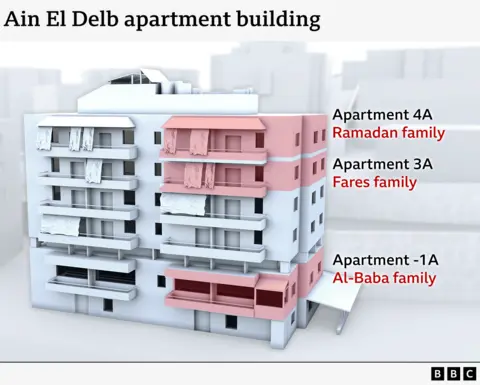
One of the Hezbollah fighters we identified was Batool’s husband, Mohammed Fares. Batool told us that her husband, like many other men in southern Lebanon, served as a guard for the group, though she added that he was not paid by Hezbollah, held an official rank, or participated in the fighting.
Israel sees Hezbollah as one of its main threats, and the group has been designated a terrorist organization by Israel, many Western governments and Gulf Arab states.
But besides its large, well-armed military wing, Hezbollah is an influential political party, holding seats in the Lebanese parliament. In many parts of the country, it is woven into the social fabric, providing a network of social services.
In response to our investigation, the IDF stated: “IDF strikes on military targets are subject to the relevant provisions of international law, including the taking of feasible precautions, and are carried out after assessing that the expected collateral damage and civilian casualties are not excessive in relation to the expected military advantage of the strike.” .
She had also previously told the BBC that she had implemented “evacuation measures” for the strike on Ain El Delb, but everyone we spoke to said they had received no warning.
United Nations experts have raised concerns about The proportionality and necessity of Israeli air strikes on residential buildings In densely populated areas in Lebanon.
This pattern of targeting entire buildings — resulting in significant civilian casualties — has been a recurring feature in Israel’s most recent conflict with Hezbollah, which began when the group escalated rocket attacks in response to Israel’s war in Gaza.
Between October 2023 and November 2024, Lebanese authorities say more than 3,960 people were killed in Lebanon by Israeli forces, many of them civilians. Over the same time period, Israeli authorities say at least 47 civilians were killed by Hezbollah rockets launched from southern Lebanon. At least 80 Israeli soldiers were also killed in southern Lebanon or as a result of rocket attacks on northern Israel.
The missile strike in Ein El Del is the deadliest Israeli attack on a building in Lebanon for at least 18 years.
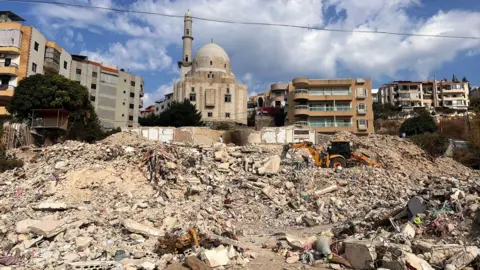 Scarlett Barter/BBC
Scarlett Barter/BBCThe village is still haunted by its influence. When we visited, more than a month into the strike, the father continued to visit the site every day, hoping for news of his 11-year-old son, whose body had not yet been found.
Ashraf Ramadan, too, returns to searching the ruins, looking for what remains of the memories his family built over the two decades they lived there.
He shows me his closet door, still decorated with pictures of the football players and pop stars he once admired. Next, he pulls a teddy bear out of the wreckage and tells me it was always on his bed.
“Nothing I find here will make up for the people we lost,” he says.
Additional reporting by Scarlett Barter and Jake Takeshi
